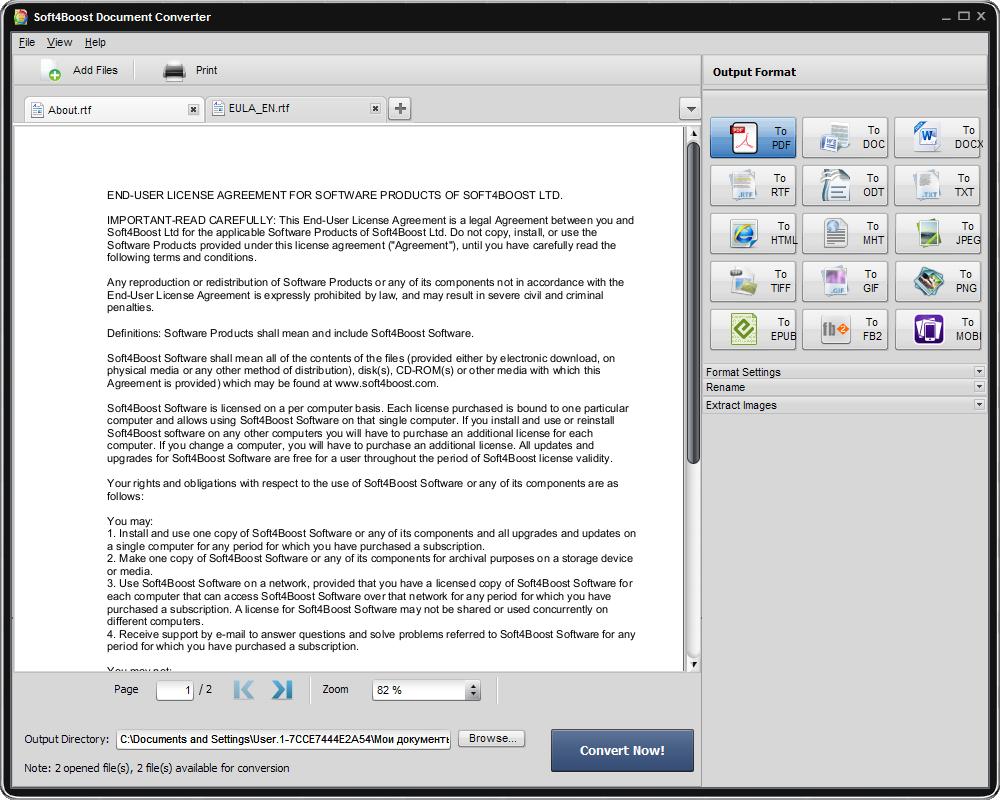How to convert documents?
- Introduction
- Step 1: Download and install Soft4Boost Document Converter
- Step 2: Run the program and load your input documents into the program
- Step 3: Select an output format and adjust its settings if available
- Step 4: Set the output name for your documents
- Step 5: Extract images from your documents (optional)
- Step 6: Set the destination folder
- Step 7: Convert your documents
If you have a set of documents of different formats and need to prepare all of them for printing or sending via e-mail, or you want to convert a text file containing tables and diagrams to an image file to insert it in your presentation - Soft4Boost Document Converter will help you solve these problems in a few easy steps.
Step 1: Download and install Soft4Boost Document Converter
Click here to download it. After the download is finished, run the S4BDocumentConverter.exe file and follow the installation wizard instructions.
Step 2: Run the program and load your input documents into the program
First of all run Soft4Boost Document Converter. To do that find the corresponding program icon on your desktop and double-click it. If you unchecked the Create desktop icon box during the installation, you can run the program from the Start menu. Please follow Start > All Programs > Soft4Boost > Document Converter.
To load files which you would like to convert click the Add Files button on the top of the program window. In the opened Windows Explorer window select the needed files and press the Open button.

After the selected documents are imported into the program you will be able to view them in the Preview Area. To navigate between them use the tabs above the Preview Area.
Step 3: Select an output format and adjust its settings if available
To select the necessary format for your output files press the appropriate format button at the Output Format section of the Working Area. You can choose one of the following options:
- To Pdf to convert your images into the Portable Document Format with the .pdf file extension;
- To DOC to convert your documents into the Microsoft Office Word Format with the .doc file extension;
- To DOCX to convert your documents into the Office Open XML Format with the .docx file extension;
- To ODT to convert your documents into the Open Document Format with the .odt file extension;
- To HTML to convert your documents into Hypertext Markup Language documents with the .html file extension;
- To MHT to convert your documents into the web page archive format with the .mht file extension;
- To TXT to convert your documents into the Standard Text Format with the .txt file extension;
- To RTF to convert your documents into the Rich Text Format with the .rtf file extension;
- To Jpeg to convert your images into the Joint Photographic Expert Group format with the .jpg file extension;
- To Gif to convert your images into the Graphics Interchange Format with the .gif file extension;
- To Png to convert your images into the Portable Network Graphics format with the .png file extension;
- To Tiff to convert your images into the Tagged Image File Format with the .tif file extension;
Note: if you select the PDF, Jpeg, Gif, Png, Tiff, TXT, HTML or MHT it will be possible to adjust format settings. The Format Settings panel will be available in the Working Area. Click the black arrow to expand it and set the desired parameters according to your needs.
Step 4: Set the output name for your documents
Open the Rename section of the Working Area and select one of the available presets from the Preset drop-down list. You can preserve the Original name or select the Text + Counter preset to type your own name in the Text field. The resulting name will be composed of your text and a file sequence number.
Step 5: Extract images from your documents (optional)
If your documents contain some images which you want to save and use independently go to the Extract Images section of the Working Area, select the Destination folder and press the Extract Images button.
Step 6: Set the destination folder
Click the Browse... button next to the Output Directory field in the Output File Area and select the folder where you would like to save your converted files.
Step 7: Convert your documents
To start the conversion process press the Convert Now! button in the right bottom corner of the program window. You will see the overall progress on the progress bar in the center of the Preview Area.
